Publications
Latest Developments in the Canadian Economic Accounts
Activities of foreign majority-owned affiliates in Canada – Provisional estimates for reference year 2011
Archived Content
Information identified as archived is provided for reference, research or recordkeeping purposes. It is not subject to the Government of Canada Web Standards and has not been altered or updated since it was archived. Please "contact us" to request a format other than those available.
- Abstract
- 1. Introduction
- 2. Concepts and frameworks
- 3. Summary of methodology
- 4. Analysis – Provisional estimates for reference year 2011
- 5. Ongoing and future work
- 6. Conclusions
- 7. References
Abstract
Foreign Direct Investment (FDI)—both Canadian Direct Investment Abroad (CDIA) and Foreign Direct Investment in Canada (FDIC)—is a useful indicator of Canada's level of economic globalization, allowing some insight on how interrelated our economic infrastructure is with jurisdictions in the rest of the world. These data provide information on the first level of connectivity of international inter-corporate relationships, which are closely related to trade and fragmented global production-distribution.
Foreign Affiliate Statistics are an extension of statistics on Foreign Direction Investment. They provide additional insight of the effect on economic agents in national economies in terms of earnings, productivity, employment, trade and foreign exposures resulting from an increasingly inter-connected and integrated global economy. Inward Foreign Affiliates Statistics (FAS) describe the activities as well as financial positions of Majority-Owned Domestic Affiliates (MODAs), a subset of Canadian direct investment enterprises and their consolidated subsidiaries operating in the Canadian economy. FAS are derived from international FDI concepts and frameworks. Statistics Canada's Inward Foreign Affiliate and Trade Statistics program is closely related to expanded estimates of outward FAS, described in a separate paper. Both inward and outward FAS are part of, and this work lays the groundwork for, the development and release of a broader set of data on the Activities of Multi-National Enterprises (AMNE). This paper presents some data development work on inward foreign affiliate statistics that is a step towards shedding light on some of these issues.
This paper found that MODAs account for a significant share of assets, operating revenues and employment in the Canadian economy. Furthermore, MODAs assumed even higher shares of exports and imports of goods and services.
1. Introduction
Foreign Direct Investment (FDI)- both Canadian Direct Investment Abroad (CDIA) and Foreign Direct Investment in Canada (FDIC)- is a useful indicator of Canada's level of economic globalization, allowing some insight on how interrelated our economic infrastructure is with jurisdictions in the rest of the world. These data provide information on the first level of connectivity of international inter-corporate relationships, which are closely related to trade and fragmented global production and distribution of goods and services. It follows that in order to broaden our understanding in this area, additional information on the operations of affiliates involved in FDI relationships is useful for policy-analytic purposes.
The Inward Foreign Affiliate Statistics Program (Inward FAS) projectNote 1 is an initiative undertaken to identify and analyze the dimensions of foreign direct investment in Canada—more specifically, the characteristics, activities, financial positions and performance of Majority-Owned Domestic Affiliates (MODAs) of foreign multinational enterprises. The resulting output will provide insight in the role foreign multinationals play in the Canadian economy.
The primary goal of this project is to establish annual estimates of inward FAS with sufficient analytical variables. This work also lays the groundwork for the future development and release of a broader set of data on the Activities of Multi-National Enterprises (AMNE).
This paper reviews the conceptual framework for statistics describing FDI and MODAs, outlines the methodology and data sources used in preparing inward Foreign Affiliate Statistics, and provides some provisional results for the reference year 2011.
2. Concepts and frameworks
Underlying the activities of foreign affiliates is the foreign direct investment relationship. A conceptual framework for FAS that is grounded in FDI assures (i) the relationship between these two datasets as well as (ii) the international comparability of FAS data. The point on international comparability cannot be understated. In the majority of countries, FAS estimates (and any underlying micro-data research) are based on the foreign direct investment concepts and frame. In the same fashion that Canada's trade, and FDI statistics are internationally comparable, so will be the new FAS estimates.
2.1. Some basics on foreign direct investment
The concept of Foreign Direct Investment (FDI) is established by the OECD Benchmark Definition of Foreign Direct Investment, Fourth Edition (BDM4) as well as by the IMF Balance of Payments and International Investment Position Manual, Version Six (BPM6). Both international standards are harmonized with respect to FDI. In short, the OECD defines direct investment as "a category of cross-border investment made by a resident in one economy (the direct investor) with the objective of establishing a lasting interest in an enterprise (the direct investment enterprise) that is resident in an economy other than that of the direct investor. The "lasting interest� is evidenced when the direct investor owns at least 10% of the voting power of the direct investment enterprise.�Note 2
Statistics Canada's FDI statistics cover Canadian entities that are engaged in a direct investment relationship. FDI measures are compiled with respect to transactions and positions with all foreign affiliates. These entities can be either a Canadian direct investor in a foreign direct investment enterprise, giving rise to Canadian Direct Investment Abroad (outward FDI, see figure 1), or a Canadian direct investment enterprise of a foreign direct investor, giving rise to Foreign Direct Investment in Canada (inward FDI, see figure 2).

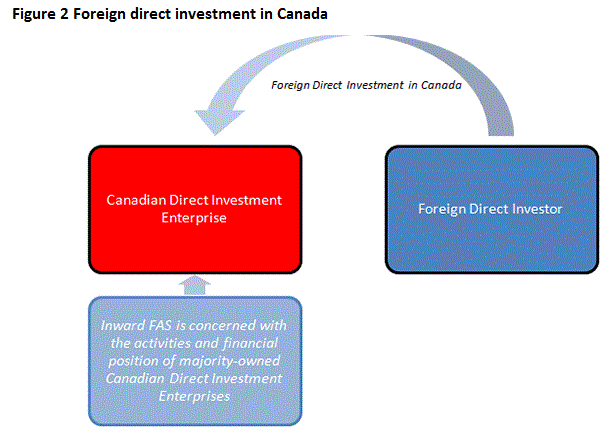
FDI statistics in Canada present international investment flows and positions in accordance with the international standards noted above. These include the more aggregated estimates in the quarterly balance of international payments,Note 3 the quarterly international investment position,Note 4 as well as the more detailed annual estimates in the annual foreign direct investment statisticsNote 5. This study relates to the latter more detailed annual dataset, with industrial composition and geographical breakdowns by country. It is further focussed on Canadian direct investment enterprises related to Foreign Direct Investment in Canada.
The international standard for the geographical distribution of FDI stock and flow data is based on the immediate investing country, which follows the actual flows of funds and corresponding inter-company claims from one economic jurisdiction to another. Where possible, it is also suggested by the BPM6 and BD4 to provide ultimate investor data as a supplementary measure in order to indicate the economy from which the investment originates. The ultimate investor concept takes on increased importance in foreign affiliate statistics.
2.2. The essentials of foreign affiliate statistics
Foreign Affiliate Statistics (FAS) are referenced in the OECD's BD4, the OECD Manual on Globalization Indicators, as well as in the IMF's BPM6. FAS are generally considered as "statistics describing the overall activity of foreign affiliates� where a foreign affiliate is "an enterprise resident in the compiling country over which an institutional unit not resident in the compiling country has control or an enterprise not resident in the compiling country over which an institutional unit resident in the compiling country has control� Note 6. These are commonly referred to as inward FAS and outward FAS, respectively. This paper deals with inward FAS and offers a framework that extends beyond the coverage of basic variables. These variables are produced on both an immediate investor country basis as well as on an ultimate investor country basisNote 7.
2.2.1. Coverage of units and the definition of control
FAS provide an extension of the impact and role of FDI. In the case of the inward FAS project, the focus is on the effects of foreign direct investment in Canada on the Canadian economy. FAS statistics are based on majority ownership which is a subset of the FDI frame, focussing on the threshold where foreign majority ownership is established—that is majority-owned domestic (Canadian) affiliates (MODAs). The ownership of more than 50% of the voting shares as defined by FDI concepts is used internationally to define the FAS universe of enterprises. This is the FDI concept of majority ownership that is a proxy for control. The FDI concept of influence includes ownership of 10% to 50% of the voting shares, but this segment is excluded from the studyNote 8. Ownership below the 10% level of voting shares is not FDI, but is referred to as portfolio investment.
2.2.2. Country of ultimate or immediate investment
The country of the ultimate investor gives information about who controls a domestic direct investment enterprise. The country of the immediate investor expands on this by providing, down the chain of related enterprises, the country that is the direct investor before entering the domestic economy. In the context of multinational enterprises using complex enterprise structures, the notions of ultimate and immediate investors provide relevant perspectives on majority ownership and control in the domestic economy (see figure 3).
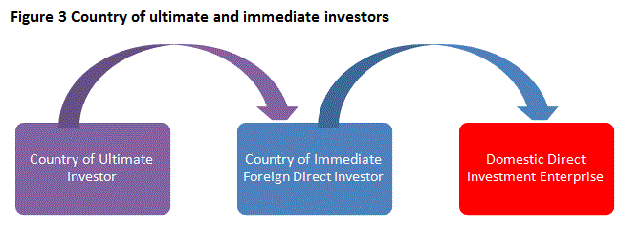
Geographically, control is associated with the country of the ultimate investor. It should be noted that when looking at the geographical breakdown of the investors in a majority ownership relationship, the concepts of ultimate investment versus immediate investment is material. By going up to the top of the organizational structure of the multinational enterprise control can be identifiedNote 9.
The provisional estimates on the financial position and operating activities of Canadian affiliates that are majority-owned are presented by industry of these affiliates as well as by country of immediate and ultimate investor.
In the instance where an affiliate's immediate investing country is the same as its ultimate investing country, there would be no difference when presenting this MODA on both investment bases; however, a special case arises where the immediate investing entity is foreign and the ultimate investing entity is Canadian, this is referred to in the international standards as "round-tripping� and is explained in section 2.4.
2.2.3. The Canadian framework for inward FAS variables
The Inward FAS variables can be categorized into to four broad groupsNote 10:
- Characteristics of MODA – number of firms, size of firms, industry, country of immediate and ultimate investors
- Activities of MODA – revenues (foreign, affiliated and non-affiliated), employment, research and development, etc.
- Capital controlled / exposures of MODA – non-financial assets, total assets, liabilities, etc.
- Performance of MODA – profits, value added, productivity (return to capital), etc
Provisional estimates of MODAs in this paper cover the following variables: Total Assets, Operating Revenue (sales), number of employees, imports of goods, exports of goods, imports of commercial services, and exports of commercial services, industry of MODAs as well as country of immediate and ultimate investors. The concepts behind these new data are equivalent to the ones used by the US Bureau of Economic Analysis for the release of their outward FAS program, including estimates for Canada. These US estimates represent the counterpart series of Canada's inward FAS.
2.2.4. Inward FAS frame definition
The frame of entities for inward FAS in this release consists of Canadian direct investment enterprises that are directly majority-owned (greater than 50% ownership) by a single foreign investor on an immediate country basis. As defined by FDI concepts, these MODAs are to include the activities of their consolidated Canadian subsidiaries. Below are some basic examples of the identification of the inward FAS universe of enterprises as illustrated in figures 4 and 5.
2.2.5. Examples of inclusions and exclusions
Example 1
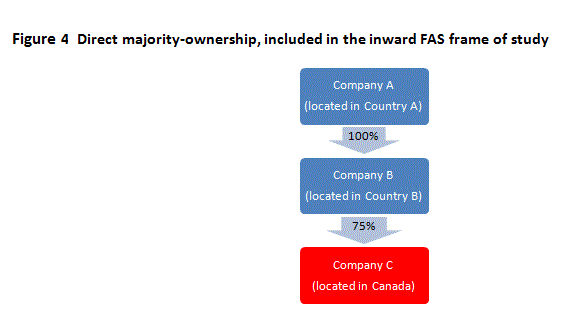
In this example (figure 4), Company C would be included in the frame as it has a single immediate foreign direct investor (Company B) that has a majority ownership stake (75%). The MODA data referring to Company C will be allocated to Country B for immediate-based analysis and to the Country A for ultimate-based analysis.
Example 2
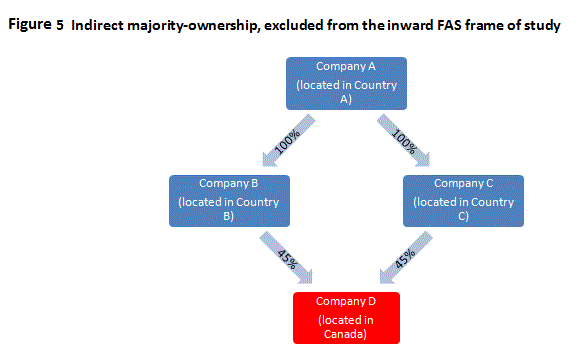
In this figure (figure 5) Company D has two immediate foreign direct investors, Companies B and C, who each owns 45% of Company D. The remaining 10% is held by other minority investors. Even though there is indirect ultimate foreign control (where company A indirectly has (100% × 45%) + (100% × 45%) = 90% control over company D), Company D does not meet the immediate-based majority ownership requirement and would be excluded from the frame as there is no single foreign direct investor who directly owns more than 50% of its equity.
2.3. Special purpose entities
Holding companies and Special Purpose Entities (SPEs) are common within the ownership structures of multi-national enterprises. They are regularly used for transiting funds and centralizing management structures. The issue in relation to FAS data and analysis is that they can obscure the ultimate industry allocation of foreign investment in the Canadian economy. In most cases SPEs were consolidated with their Canadian subsidiaries and the industry that contributes to the primary activity of the consolidated enterprise group was chosen. This provides a more accurate representation of the industries being influenced by foreign investors. In cases where this was not possible, the SPEs industry classification was left as is (the Management of companies and enterprises).
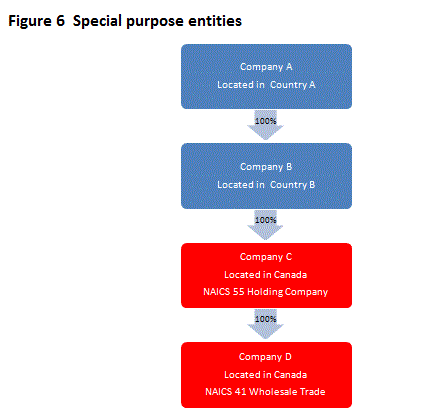
In this instance, Company C is a majority-owned domestic affiliate with immediate investing country B and ultimate investing country A. Company D is a wholly-owned Canadian subsidiary of Company C and therefore both Company C and Company D are included in the Inward FAS frame of study. The industrial breakdown of MODA variables allocate data based upon North American Industry Classification (NAICS) coding. In the case where companies C and D are consolidated and reported for by Company C (as is a common occurrence), all data would therefore be allocated to NAICS code 55 and the industry truly impacted by foreign control (NAICS 41) would remain hidden.
2.4. A special case: foreign investment in Canada originating from Canada
The inward FAS frame is defined by Canadian companies whose immediate direct investor has majority ownership. In this context, there exists the possibility that the immediate direct investor is ultimately controlled by another Canadian entity. This is referred to in the international standards as "round tripping� and is defined where funds from an entity in one economy are invested in an entity resident in a second economy that are then invested in another entity in the first economy. This arises only when compiling data on the country of immediate and ultimate bases. The provisional estimates in section 4 include round-trip values that are allocated to Canada. It may seem counter-intuitive to have data allocated to Canada in a foreign-ownership chart but what this data represents are the characteristics of entities whose ownership starts in Canada, is then routed through one or more foreign countries, and then ends up back in Canada again.
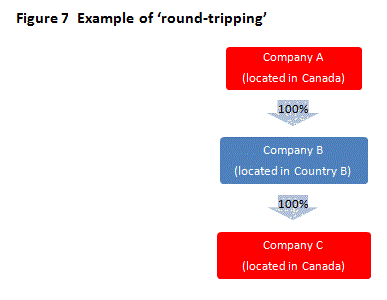
In figure 7, the MODA is Company C whose immediate direct investor is Company B and whose ultimate investor is Company A. In this case the MODA referring to Company C will be allocated to Country B for immediate-based analysis and to Canada for ultimate-based analysis.
3. Summary of methodology
One advantage of a centralized statistical agency is that it compiles a wealth of economic data from ongoing surveys and administrative programs. As a result, a data linkage approach was identified as the most efficient way to generate inward FAS estimates at Statistics Canada; and, it also allows the project to benefit from the existing methodological and analytical support available within Statistics Canada
The statistical work is comprised of two phases: 1) frame definition 2) record linkage. Phase 1 made use of the inward foreign direct investment frame, complemented by administrative data to define the universe of Canadian companies including their subsidiaries that are directly majority-owned (controlled) by a single foreign investor. Primary data sources include the foreign direct investment frame (FDIC survey), various tax schedule information, the Inter-Corporate Ownership database (ICO), and the parent-child consolidated reporting structure that is maintained by the Statistics Canada's Business Register (BR)Note 11.
Phase 2 linked this list of companies with descriptive data from a variety of other sources, including financial data, employment data, and international merchandise trade data. Linkages were carried out based on the unique operating entity number that is available on the Business Register and the individual survey (employment, international trade, and financial statistics) databases at Statistics Canada.
4. Analysis – provisional estimates for reference year 2011
4.1. Summary estimates of majority-owned domestic affiliates (MODAs) in Canada – ultimate and immediate investing countries
4.1.1. Select aggregate financial and operating data of MODAs
In 2011, 18% of total assets in the books of domestic enterprises were ultimately controlled by foreign investors (see Table 1 and Chart 1). On an immediate investment basis foreign majority ownership of Canadian assets was marginally larger at 19%, with the difference representing the cases where the foreign firms are owned ultimately by a Canadian parent—the so-called round tripping described in section 2.4Note 12,Note 13.
| Geography of ownership | Ultimate-based investing country | Immediate-based investing country | ||||
|---|---|---|---|---|---|---|
| Total assets | Operating revenue | Employment | Total assets | Operating revenue | Employment | |
| percent | ||||||
| Foreign | 18 | 26 | 12 | 19 | 26 | 12 |
| U.S. | 9 | 15 | 8 | 8 | 13 | 7 |
| Non-U.S. | 9 | 11 | 4 | 10 | 13 | 5 |
| Canadian | 82 | 74 | 88 | 81 | 74 | 88 |
| Total Canadian economy | 100 | 100 | 100 | 100 | 100 | 100 |
|
Note: Figures may not add up due to rounding. Source: Inward Foreign Affiliate Statistics, provisional 2011 results |
||||||

Operating revenue generated by MODAs amounted to 26% of total revenues in the Canadian economy. However, majority-owned domestic affiliates accounted for only 12% of employment in Canada, suggesting that MODAs generate income with relatively efficient use of labour.
4.1.2. Total assets of MODAs by investing country
Geographically, the ultimate country statistics shed light on capital controlled by foreigners in the Canadian economy; the immediate country statistics are more relevant in terms of economic transactions related direct investment positions.
The United States—as Canada's largest direct investor—controls close to 9% of total assets in the Canadian economy on an ultimate basis at the end of 2011. Measured on an immediate basis, given that some of US direct investment is channelled through other countries, the US share of majority ownership in Canadian enterprise's assets is about 8%. Other countries account for the balance of the control over Canadian assets, with UK holding the next largest share at 2%.
Out of the foreign controlled assets on the ultimate basis, the US accounts for the lion's share at 51% (see Chart 2). On an immediate investor basis the US claim is reduced to 46%, reflecting the fact that ownership is exercised through affiliates in other countries.
The United Kingdom ranks second in terms of foreign controlled assets, at 13%, but falls to 11% on an immediate basis. While engaged in the Canadian economy to a lesser extent, Japan's share of ownership of Canadian capital is twice as large on an ultimate basis as compared to an immediate basis. This pattern indicates that a certain amount of investment that originates in the UK, or in Japan, flows through other countries before entering the Canadian economy.
The Netherlands shows the opposite pattern. This country's share goes from 7% on an ultimate basis to 21% on an immediate basis. As much smaller investors to Canada, Australia, Luxembourg and Bermuda exhibit a similar pattern. This underlines that these countries are used, to a certain extent, to route investment, before the funds are placed in Canada. Canada accounts for a very small proportion of MODA capital controlled on an ultimate basis.

4.1.3. Operating revenue of MODAs by investing country
Majority-owned domestic affiliates generated approximately 26% of all business gross revenue (sales) in Canada in 2011. A total of 56% of all foreign controlled revenues in Canada are ultimately generated by the United States (see Chart 3). On an immediate investment basis, the US ownership share falls to 51%. The same pattern is evident for the UK and Japan. In parallel with the total assets section, Netherlands along with Luxembourg accounted for a much lower share of gross revenue on an ultimate basis than on an immediate basis.

4.1.4. Employment of MODAs by investing country
MODAs accounted for 12% of total employment in Canada on both bases in 2011, or 1.8 million jobs. Investment from the US alone generated nearly 1.2 million jobs, equivalent to 8% of total employment in Canada. Of all the MODA employees, nearly two-thirds are under US control (see chart 4). On an immediate investment basis the share is reduced to 58%. On an ultimate investment basis, the UK and France are the next largest countries for employment. On an immediate investment basis, France's share drops notably. As noted with total assets and revenue, the employment generated by the Netherlands is much larger on an immediate basis as opposed to an ultimate basis.

4.1.5. Select financial and operating data MODAs by Industry of Affiliate
Industrial distributions vary depending on the FAS variable under consideration, though remains relatively concentrated. Nevertheless, for total assets, total revenue, and employment, the top 3 industries account for 60% to 70% of the foreign controlled portion (see Charts 5 to 7).
The finance and insurance industry (NAICS code 52) accounts for 31% of all foreign majority-owned assets, but only 6% of operating revenues and 3% of employment. This is consistent with the large asset base that financial companies typically maintain relative to the number of employees or other operational variables. For example, the management of companies and enterprises industry makes up 13% of all foreign majority-owned assets.
Manufacturing is highly ranked across the three FAS variables. It has the second highest share of MODA assets with 22%, and the highest share of both operating revenues and employment with 34% and 29%, respectively. The retail (21%) and wholesale (10%) industries together account for nearly one-third of MODA employment.
The mining, quarrying, and oil and gas extraction industry is third in terms of its share of MODAs assets and operating revenues with a 14% share of each.



4.2. Trade in goods and services of MODAs by investing country
In comparison to the financial and operational FAS variables, a much higher proportion of Canadian international trade is carried out by MODAs. In fact, 44% of goods exports and 52% of goods imports in Canada are from MODAs, while 36% of commercial services exports and 42% of commercial services imports takes place via MODAs.
Out of the foreign controlled goods trade, 44% of exports and 52% of imports are controlled by the US (see Charts 8 and 9). For services, nearly two-thirds of both exports (63%) and imports (62%) are controlled by the US (on an ultimate basis) (see Charts 10 and 11). On an immediate basis, a similar share was reported by the US.
The UK ranks second on trade with 24% of goods exports and 10% of goods imports on an ultimate basis. On an immediate basis, its share is much lower on the exports side. Japan follows closely, controlling 7% of goods exports and 10% of goods imports. The trade controlled by the Netherlands was much smaller than that on the immediate basis, a pattern observed with the other variables (assets, total revenue and employment).


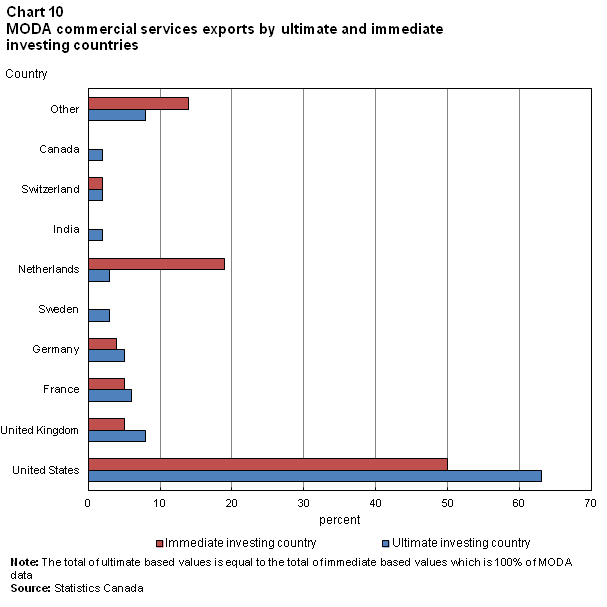
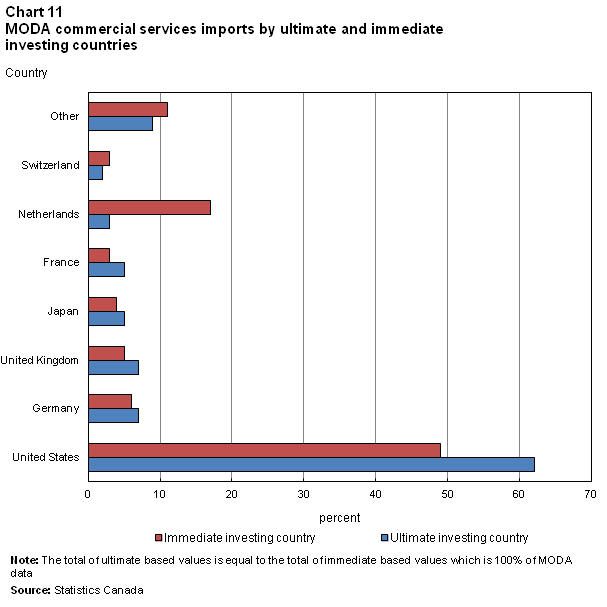
4.3. Round trip foreign direct investment in Canada
For reference year 2011, the Canadian companies involved in round-tripping held 0.86% of MODA's total assets, earned 0.35% of MODA's operating revenue and employed 0.61% of MODA's employment. The ultimate Canadian investment of these companies was routed through other countries—Bermuda, Denmark, France, Iceland, Luxembourg, the Netherlands, and the United States—before re-entering the Canadian economy.
5. Ongoing and future work
5.1. Ongoing work: Data quality assurance
The objective of this project is to put in place ongoing annual estimates of inwards FAS data and to convert the provisional estimates in this paper into official estimates. As part of this work, methodology and data sources will continue to be investigated and evaluated, as part of data quality assurance practices.
Detailed and comprehensive FAS statistics are currently being produced by the United States' Bureau of Economic Analysis. A comprehensive review of Canadian inward FAS against US outward FAS with reference to Canada will be undertaken for data validation purposes. For certain variables (e.g. employment) an initial review indicated that the bilateral data are very close; for other variables the differences are larger but can be explained.
5.2. Ongoing and future work
5.2.1. Time series generation
Clearly inward FAS data are more useful in a time series context, and the plan is to produce a few additional years for official release. The methodology used to generate 2011 FAS estimates will be applied to past years' data in order to generate a time series. The establishment of the length of the time series is to be determined. This will depend on the coherence of source data, in terms of whether past data can reliably be compared to 2011 data and onward.
5.2.2. Expansion of variable analysis
While the current work is restricted in terms of variables (revenues, assets, employees and trade data), a more detailed set of data will be available in the future. For example, following the framework noted above, analysis might be possible on the following: All balance sheet and income statement related variables (profits, current assets, non-financial assets, capital formation, liabilities etc), financial ratios (current ratio, asset turnover, debt to equity, etc.), foreign direct investment ratios (Total Assets ÷ FDI, Debt ÷ FDI), trade data broken down into affiliated and non-affiliate traded, and research and development data. The FAS trade estimates could be expanded to look at some degree of commodity details as well as links between FDI and trade by country. Lastly, the links between industry and geography could be further explored, subject to confidentiality. The inclusion of additional variables will be dependent on the results of further investigation so as to ensure availability and quality on any new estimates.
5.3. Future work: FAS in a broader conceptual framework
FAS statistics are part of, and lay the groundwork for, the development and release of a broader set of Activities of Multi-National Enterprises (AMNE) statistics. AMNE statistics are comprised of similar variables to FAS, but "reflect the overall operations of MNEs� operating in the domestic economy, "whether or not financed by the direct investor.�Note 14
In terms of scope, AMNE statistics cover the enterprises studied by both inward and outward FAS programs. AMNE output could also include a presentation of Canadian MNEs consolidated with respect to their foreign operations. The construction of these statistics is currently being planned as the next phase of the FAS work. AMNE can be combined with the trade by enterprise characteristics databases (indeed the current work has established that link), and contrasted with economy-wide totals by industry. The need to understand internationalization of operations and the related performance of the foreign affiliates render FAS and the broader AMNE statistics are important analytical tools.Note 15
To this end, Statistics Canada is working on an overall enterprise globalization framework. Such a framework can provide a more comprehensive depiction of Canada's engagement in the global economy.
6. Conclusions
It is a well established fact that Canada is an open economy, as demonstrated by the share of trade in GDP, the reliance on inward foreign direct investment post World War II, and the trend to relatively stronger Canadian direct investment abroad since the mid-1990s. Direct investment activity tends to alter production functions, and global production has become increasingly fragmented across economies with differential effects. This paper has shed new insight on the extent and role of foreign direct investment in Canada, by developing and presenting estimates of the operations of foreign majority-owned domestic affiliates.
The main conclusion to be drawn from the provisional estimates presented in this paper is that majority-owned domestic affiliates play a significant role in the Canadian economy with respect to ownership of assets, income generation, employment, and especially with respect to trade flows. Future developmental work will add to the analytical capacity of these new Inward foreign affiliate statistics.
7. References
European Commission, IMF, OECD, UN, World Bank. (2009). System of National Accounts 2008. European Commission, IMF, OECD, UN, World Bank, New York.
Eurostat. (2009). Foreign AffiliaTes Statistics (FATS), Recommendations Manual. Eurostat. European Commission, Office for Official Publications of the European Communities.
International Monetary Fund. (2009). Balance of Payments and International Investment Position Manual Sixth Edition (BPM6). International Monetary Fund. Washington: International Monetary Fund.
The Organization for Economic Co-operation and Development. (2005). Measuring Globalization: OECD Handbook on Economic Globalization Indicators. The OECD. OECD Publishing.
The Organization for Economic Co-operation and Development. (2008). OECD Benchmark Definition of Foreign Direct Investment, Fourth Edition. OECD. OECD Publisher.
United Nations. (2010). Manual on Statistics of International Trade in Services. United Nations Secretariat, Department of Economic and Social Affairs, Statistics Division. New York: United Nations Publications.
World Economic Forum. (2013). Foreign Direct Investment as a Key Driver for Trade, Growth and Prosperity: The Case for a Multilateral Agreement on Investment. Global Agenda Council on Global Trade and FDI. Geneva: World Economic Forum.
Notes
- Date modified:
